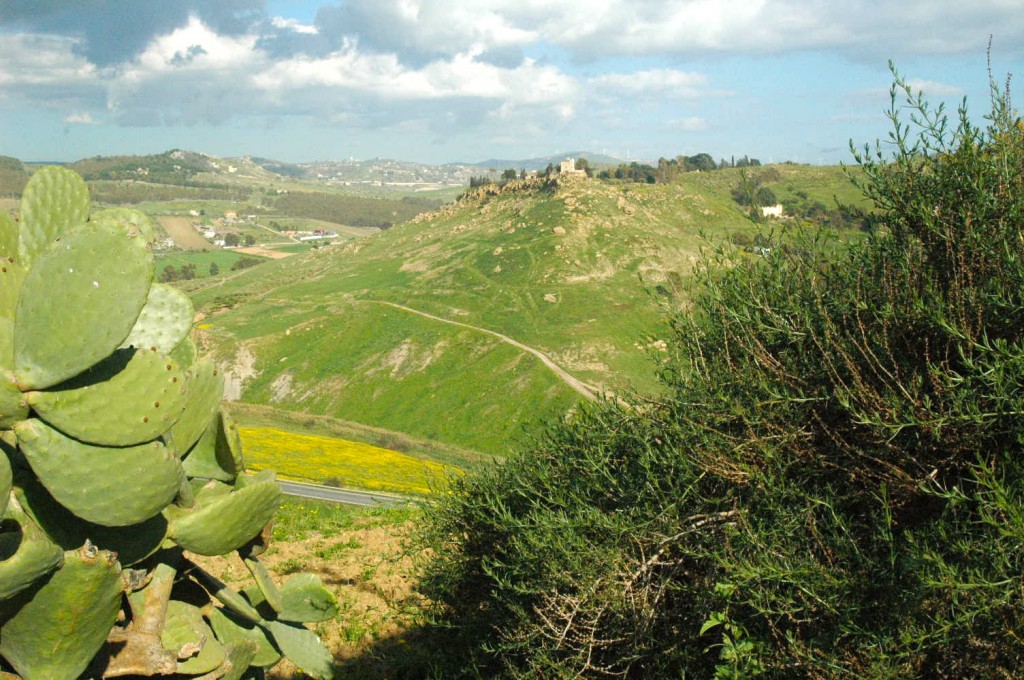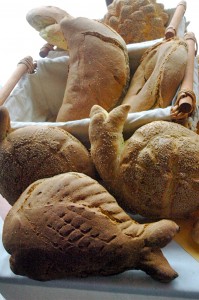Day 1: Under the Sicilian Sun
Probably there is no better guidebook to the real and the mythical Sicily than Giuseppe Tomasi di Lampedusa’s The Leopard, the powerful historical novel about Sicilian life at the time of the Risorgimento [Review of the book from THE GUARDIAN]. I took it with me on a flight to Palermo last week and as we drove on the coastal road toward Trapani and our hotel, past dark-skinned children playing along the roadside and men with the bluest of eyes, yellow hair and ruddy complexions, I remembered his image of Sicily as the “America of antiquity.” Positioned strategically on the Strait of Messina between North Africa and mainland Italy, the island, the largest in the Mediterranean, was an easy stepping stone for marauders, invaders, and fortune-seekers. This is where Greeks, Phoenicians, Romans, Arabic, Norman, Spanish alternately ruled and plundered for 3,000 years.
A nation’s food is a living relic of its history. Sicilian food is a banquet of all its historical layers, flavored also by Africans and Europeans. I came to the island’s northwestern Trapani province for an agricultural exhibit of provincial wines, olive oils, pistachios, almonds, herbs, preserves and confections, an exposition sponsored by the local Chamber of Commerce. I wanted to taste the fruit of the year’s harvest and talk first-hand to the artisans–olive oil producers, vintners, pasta makers, Pantelleria caper farmers, to name few–whose singularly local ancestral crafts form the backbone of the region’s legendary kitchens. And since Trapani has been the tuna-fishing center of Italy since Phoenician times, I couldn’t pass up an opportunity to savor some of the best tuna in the world. Insights from the artisans who make Trapani’s celebrated foods–and some of their recipes–will follow in single-subject entries as this journal unfolds…
At the hotel, Tonnara di Bonagia, on the site of an ancient tuna fishery, the first taste of Trapani awaited us in our room: a plate of milky mozzarella and cigliegini (“little cherries”), astonishingly sweet local cherry tomatoes, and a basket filled with delicious bread baked from heritage wheat, which Sicilian farmers are making a concerted effort to revive.
And what a delight it was after the styrofoam-variety rolls we are faced with in Italian hotels these days. As for the cheese, this was not the not the true water buffalo mozzarella native to the Naples area–ideally, that luscious fresh cheese (not actually a cheese since it is not subjected to fermentation) should be eaten within two hours of making, as any mozzarella di bufala maker would tell you. This tangy, charming version was probably a sheep’s milk variation, and hand-formed like little dumplings. Along with these simple but satisfying offerings came a full bottle of fragrant and flavorful Trapanese olive oil, implying that one shouldn’t skimp with it. I poured it lavishly over all, as was intended. Washed down with the local Erice Nero D’Avola DOC house wine it was as good a meal as I’d ever want.



 Follow
Follow
 email
email
Hi Julia,
Been meaning to reconnect. Like you, I love The Leopard — I think it’s one of the great modern novels and one of the most under appreciated.
On you suggestion, I picked up the DK cookbook and have been having a great time exploring.
How was the tuna?
Just saw the rendering for the Ridgefield theater — looks great and looks like the purchase will get the town’s approval, never a foregone conclusion around here when it comes to construction in the center of town.
Take care.
Jim
Hi Jim,
I don’t know why this post, written in September, went out again. We figure it must have been some kind of glitch on Word Press. My apologies. My latest post is “Feasting with Leopards.” If you’re interested in The Leopard, you’ll want to see it.
Glad you’re exploring the Classic Italian Cookbook. Let me know how your cooking adventures go. Now, I’m wracking my brain about the tuna you mentioned. I don’t remember buying tuna with you?
Yup, sounds like the Ridgefield project is humming along nicely. Maybe we can all get together for dinner there one of these days.
–J